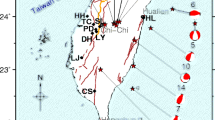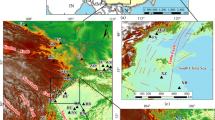Abstract
It is shown that temporal variation in hydrochemistry may be attributed, in part, to continuous seismotectonic activity occurring before the onset of the 1995 “Kobe” earthquake, Japan, challenging the “one earthquake–one signal” hypothesis with respect to potential precursory signals to this devastating event. A possible continuous seismotectonic influence on chloride and sulphate ion-concentration is evaluated with aggregate earthquake-information by transforming a multivariate earthquake time series (including coordinates and magnitude) into a one-dimensional time series (considering geometric relationships between earthquakes and the well-site). A piecewise analysis of ion-concentration and seismotectonic-activity time series compares trends and change points between the two time series: a positive correlation (before the proposed onset of the preparation stage) is followed by a negative correlation (during the proposed preparation stage) which, in turn, is succeeded by a positive correlation (after the heaviest aftershock sequences). This suggests that seismotectonic processes occurring before the Kobe earthquake dynamically influenced aquifer characteristics, leading to temporal variations in the hydrochemical time series. Accordingly, a dynamic change in the mixing ratios of waters with different hydrochemical characteristics is proposed as a mechanism for explaining observed variation. The research can be extended by considering vectors in the stress field that lead to changes in the aquifer-well system.
Résumé
D’après les observations, des fluctuations hydrochimiques temporaires peuvent être partiellement imputées à une activité sismotectonique permanente précédant le début du train d’ondes du séisme de Kobe (Japon) en 1995. Ceci remet en cause l’hypothèse “un séisme – un signal”, concernant les signaux précurseurs potentiels de cet événement dévastateur. Une potentielle influence sismotectonique continue sur les concentrations en ions chlorure et sulfate est estimée par recoupement des informations sismiques, en transformant les séries temporelles multivariables (incluant les coordonnées et la magnitude) en une série temporelle unidimensionnelle (en prenant en compte les relations géométriques entre les séismes et l’emplacement du puits). Une analyse par morceaux des séries temporelles des compositions ioniques et de l’activité sismique compare les tendances et les points d’inflexion entre les deux séries : une corrélation positive (précédant l’amorce des précurseurs) est suivie d’une corrélation négative (synchrone des précurseurs), précédant elle-même au final une corrélation positive (après les répliques les plus intenses). Ceci suggère que les processus sismotectoniques précédant le séisme de Kobe ont influencé dynamiquement les caractéristiques de l’aquifère, causant des variations dans les séries hydrochimiques temporelles. Suivant le même raisonnement, un mécanisme proposé pour expliquer les variations observées implique un changement dynamique dans les proportions de mélange des eaux selon les différents paramètres hydrochimiques. La recherche peut être étendue en prenant en compte les vecteurs du champ de contraintes qui génèrent les changements dans le système puits-aquifère.
Resumen
Se muestra que la variación temporal en hidroquímica puede atribuirse en parte a la continua actividad sismotectónica que ocurrió antes del inicio del terremoto de 1995 en Kobe, Japón, lo que desafía la hipótesis “un terremoto-una señal” en relación con las señales precursoras potenciales para este evento devastador. Se evalúa una posible influencia sismotectónica continua en la composición de la concentración de iones sulfato y cloruro con información agregada de terremotos mediante la transformación de series de tiempo multivariables de terremotos (incluyendo coordenadas y magnitud) a series de tiempo en una dimensión (considerando relaciones geométricas entre terremotos y el sitio del pozo). Un análisis por partes de las concentraciones de iones y series de tiempo de actividad sismotectónica compara tendencias y puntos de cambio entre las dos series de tiempo: una correlación positiva (antes del inicio propuesto de la etapa de preparación) es seguido por una correlación negativa (durante la etapa de preparación propuesta) la cual, a su vez, es continuada por una correlación positiva (después de las fuertes secuencias de réplicas). Esto sugiere que los procesos sismotectónicos que ocurrieron antes del terremoto de Kobe influyeron dinámicamente en las características de los acuíferos, ocasionando variaciones temporales en las series de tiempo hidroquímicas. Por lo tanto, se propone que un cambio dinámico en las relaciones de mezcla de las aguas con las diferentes características hidroquímicas es un mecanismo que explica la variación observada. La investigación puede extenderse tomando en consideración los vectores del campo de esfuerzos que pueden conducir a cambios en el sistema pozo-acuífero.






Similar content being viewed by others
References
Bella F, Biagi PF, Caputo M, Cozzi E, Della Monica G, Ermini A, Gordeez EI, Khatkevich YM, Martinelli G, Plastino W (1998) Hydrogeochemical anomalies in Kamchatka (Russia). Phys Chem Earth 23:921–925
Bernard P (2001) From the search of “precursors” to the research on “crustal transients”. Tectonophysics 338:225–232
Biagi PF (1999) On the existence and complexity of empirical precursors. Nature, Letter March 18, 1999
Biagi PF, Ermini A, Cozzi E, Khatkevich YM, Gordeev EI (2000) Hydrogeochemical precursors in Kamchatka (Russia) related to the strongest earthquakes in 1988–1997. Nat Haz 21:263–276
Bolognesi L (1997) A tentative correlation between seismic activity and changes in the composition of thermal waters on Vulcano Island, Italy. Geothermics 26(3):379–392
Bortz J (1993) Statistik (für Sozialwissenschaftler) [Statistics (for sociologists)]. Springer, Berlin Heidelberg New York, p 753
Dobrovolsky IP, Zubkov SI, Miachkin VI (1979) Estimation of the size of earthquake preparation zones. Pure Appl Geophys 117:1025–1044
Geller RJ (1997) Earthquake prediction: a critical review. Geophys J Int 131:425–450
Hartmann J (2005a) Long-term seismotectonic influence on the hydrochemical composition of a spring located at Koryaksky-Volcano, Kamchatka deduced from aggregated earthquake information. Int J Earth Sciences DOI: 10.1007/s00531-005-0055-5
Hartmann J (2005b) Difference information criterion for the analysis of a seismotectonic influence on a radon time series at KSM-site, Japan. Geophys J Int 160:891–900
Hartmann J, Levy JK (2005) Hydrogeological and gasgeochemical earthquake precursors: a review for application. Nat Haz 24:204–279
Hartmann J, Berner Z, Stüben D, Henze N (2005) A statistical procedure for the analysis of seismotectonically induced hydrochemical signals: a case study from the Eastern Carpathians, Romania. Tectonophysics 405:77–98
Hamza VM (2001) Tectonic leakage of fault bounded aquifers subject to non-isothermal recharge: a mechanism generating thermal precursors to seismic events. Phys Earth Planet Int 126:163–177
Hauksson E (1981) Radon content of groundwater as an earthquake precursor: evaluation of worldwide data and physical basis. J Geophys Res 86:9397–9410
Heinicke J, Koch U (2000) Slug flow: a possible explanation for hydrogeochemical earthquake precursors at Bad Brambach, Germany. Pure Appl Geophys 157:1621–1641
Igarashi G, Wakita H (1990) Groundwater radon anomalies associated with earthquakes. Tectonophysics 180:237–254
Igarashi G, Saeki S, Takahata N, Sumikawa K, Tasaka S, Sasaki Y, Takahashi M, Sano Y (1995) Groundwater radon anomaly before the Kobe earthquake in Japan. Science 269:60–61
Itoh Y, Takemura K, Ishiyama T, Tanaka Y, Iwaki H (2000) Basin formation at a contractional bend of a large transcurrent fault: Plio-Pleistocene subsidence of the Kobe and northern Osaka Basins, Japan. Tectonophysics 321(3):327–341
Johansen A, Sornette D, Wakita H, Tsunogai U, Newman WI, Saluer H (1996) Discrete scaling in earthquake precursory phenomena: evidence in the Kobe earthquake, Japan. J Phys I France 6:1391–1402
Kanaori Y, Kawakimi S (1996) The 1995 7.2 magnitude Kobe earthquake and the Arima-Takatsuki tectonic line: Implications of the seismic risk for central Japan. Eng Geol 43(2–3):135–150
King CY, Koizumi N, Kitagawa Y (1995) Hydrochemical anomalies and the 1995 Kobe earthquake. Science 269:38–39
Kuroda K, Sakamaki Y, Mochizuki T, Obi I (1981) On the quality of groundwater yielded within granite regions accompanying fault zones. J Jpn Soc Eng Geol 22:118–131
Kusaka Y, Fukui Y, Tsuji H, Tamari Y, Fujiwara Y (1982) Studies on chemical species dissolved in groundwaters from the Neogene strata: a comparison between shallow and deep groundwaters. Jpn J Limnol 43:254–262
Molchan GM (1997) Earthquake prediction as a decision making problem. Pure Appl Geophys 149:233–247
Montgomery DR, Manga M (2003) Streamflow and water well responses to earthquakes. Science 300:2047–2049
Muir Wood R (1994) Earthquakes, strain-cycling and the mobilisation of fluids. In: Parnell J (ed) Geofluids: origin, migration and evolution of fluids in sedimentary basins. Geol Soc Spec Publ 78:85–98
Oki Y, Hiraga S (1988) Groundwater monitoring for earthquake prediction by an amateur network in Japan. Pure Appl Geophys 126:212–240
Sato T, Takahashi M, Matsumoto N, Tsukuda E (1995) Anomalous ground water discharge after the 1995 Kobe (Hyogo-ken-nanbu) earthquake in the Awaji Island. Chichitsu News 491:29–32
Shapiro MH, Melvin JD, Tombrello TA, Fong-Liang J, Giu-Ru L (1980) Automated radon monitoring at a hard-rock site in the southern California transverse ranges. J Geophys Res 85:3058–3064
Silver PG, Wakita H (1996) A search for earthquake precursors. Science 273:77–78
Stephenson EL, Maltman AJ, Knipe RJ (1994) Fluid flow in actively deforming sediments: “dynamic permeability” in accretionary prisms. In: Parnell J (ed) Geofluids: origin, migration and evolution of fluids in sedimentary basins. Geol Soc Spec Publ 78:113–125
Toutain JP, Baubron JC (1999) Gas geochemistry and seismotectonics: a review. Tectonophysics 304:1–27
Toutain JP, Munoz M, Poitrasson F, Lienard AC (1997) Springwater chloride ion anomaly prior to a M’L=5.2 Pyrenean earthquake. Earth Planet Sci Lett 149:113–119
Tsunogai U, Wakita H (1995) Precursory chemical changes in groundwater: Kobe earthquake, Japan. Science 269:61–63
Tsunogai U, Wakita H (1996) Anomalous changes in groundwater chemistry-possible precursors of the 1995 Hyogo-ken Nanbu earthquake, Japan. J Phys Earth 44:381–390
Wakita H, Nakamura Y, Kita I, Fujii N, Notsu K (1980) Hydrogen release: new indicator of fault activity. Science 210:188–190
Zongjin M (1990) Earthquake prediction: nine major earthquakes in China. Springer, Berlin Heidelberg New York, p 332
Acknowledgements
This work was partly financed by the German Science Foundation (DFG) within the framework of the post-graduate programme “Natural Disasters” and the Japanese Society for Promotion of Science within the framework of the 21st Century Center of Excellence Program. The authors are thankful for the constructive comments of the reviewers and the editors.
Author information
Authors and Affiliations
Corresponding author
Additional information
The influence of seismotectonics on precursory changes in groundwater composition for the 1995 Kobe earthquake, Japan.
Rights and permissions
About this article
Cite this article
Hartmann, J., Levy, J.K. The influence of seismotectonics on precursory changes in groundwater composition for the 1995 Kobe earthquake, Japan. Hydrogeol J 14, 1307–1318 (2006). https://doi.org/10.1007/s10040-006-0030-7
Received:
Accepted:
Published:
Issue Date:
DOI: https://doi.org/10.1007/s10040-006-0030-7




